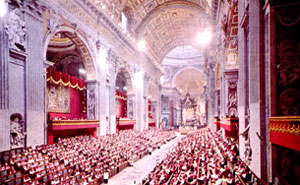
|
American Catholic Press
16565 S. State Street, South Holland, Illinois 60473
|
|||||||||||||||||||||
|
by Archbishop Rembert G. Weakland, O.S.B
Intelligent and Committed Liturgists
These were the principles that found their way into the Constitution on the Sacred Liturgy. These goals and aims were also the guiding principles for the implementation in subsequent years. The liturgical renewal was set in place by an ecumenical council, not by a group of radical individuals seeking some way to bring ruin on the Church. It was prepared for over a long period of time by intelligent and committed people. Pope Paul VI was personally very concerned about the implementation of the council and of the document on the liturgy in particular. He followed its course carefully. It was also true that he anguished over every decision that had to be made. I recall in January 1968 attending the Masses celebrated in his chapel using the Novus Ordo for the first time. He had invited me to be present three evenings in a row, together with a small group of worshipers, in order to experience the new rite in various degrees of solemnity. After each Mass, five to seven of us were invited to his office for over an hour's discussion with him about the experience. He was not taking this decision to publish the new rite lightly, nor was he leaving such a decision to others.
Accurate and Thorough Preparation One point was most evident in the Pope's mind: He did not want to see two Latin rites. He made it clear over and over again that the revision in progress was a revision of the Latin or Roman rite. It was not to be conceived of as a new or parallel rite. He was convinced that two Latin rites would only be divisive in the Church. How right he proved to be! No one can deny that immense scholarship and zeal went into this revision of the Latin rite by both the Consilium ad Exequendum (1964-69) and by the later Congregation for Worship (1969). It took time to produce all the books needed, but the urgency did not impede the attempt to be as accurate and as thorough as possible. It is also true that after the council abuses arose throughout the Church. Many practitioners were not educated in the history and theology of liturgy and suggested local changes that were often in bad taste or simply wrong. These all too frequent "abuses" were, however, the product of zeal and exuberance, not of bad will. Often they were projected as adaptations to a specific culture, but in most cases the innovators did not analyze clearly what that culture was about nor what were the perennial values in the liturgy that should be preserved. Perhaps the most significant concern voiced at that time was fear of the loss of a sense of awe or respect, of the mysterium tremendum, that is so important in any liturgical celebration.
|

